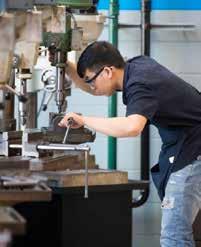YOUR GUIDE TO Getting Certified

Want a Career Boost in Engineering Technology? Get OACETT Certified

Engineering and applied science technicians and technologists play a vital role in various industries like manufacturing, construction, industrial automation and more. An integral part of all engineering projects, they work directly with teams of engineers, scientists, and tradespeople.


Engineering technicians use a practical approach to solve technical problems. Their responsibilities may include testing, troubleshooting, inspection, calibration, design drafting, quality control and field supervision. On the other hand, an engineering technologist uses an applied approach based on an understanding of specific technology discipline and carries out a wide range of complex work, either independently or under general direction. Examples include design, production, supervision, and management. Both approaches make key contributions to engineering projects in construction, research, safety, and beyond.
The profession is vast in opportunity and offers a lot of room for personal and professional growth. Recognizing this, Ontario colleges have programs that are successfully launching young workers into these careers. And afterwards, many graduates compliment their education with an additional credential.
Validated and employable

That extra step is a certification from the province’s most reputable independent certifying body, OACETT. A self-governing nonprofit, this professional association has over 21,000 members spanning 15 disciplines. It has 27 chapters across Ontario and is a founding member of Technology Professionals Canada. The association offers certifications to engineering and applied science technicians and technologists, conferring the certifications C.Tech. (Certified Technician) and C.E.T. (Certified Engineering Technologist).
“We provide certifications because these jobs have aspects of public safety and security, so there needs to be a regulatory process,” says Cheryl Farrow, MBA, CAE, OACETT Chief
Katherine Cappellacci
Executive Officer. "Certification represents a third-party seal of approval and is a mark of professionalism and ethics that is recognized and sought by employers".
There are major personal and professional benefits to having these certifications. It enhances worker employability because it proves they possess the skills employers want.
The ideal combination Plus, it’s recognized across the country, which offers certified national employment opportunities. Employability isn’t the only benefit; the certification also leads to higher rates of pay and promotion. “Our members followed the Ontario college stream or are internationally educated,” Farrow adds. “Colleges do a great job of prepping grads for their first job, and OACETT is there to provide ample networking, advancement and leadership growth opportunities, continuous learning, and so much more. It’s the difference between a job and a career.”
Colleges encourage students to get certified because it makes them more desired by employers. “A college education combined with OACETT certification is the perfect way to start a career,” says Neal Mohammed, Director at the Barrett Centre for Technology Innovation at Humber College. “The certification validates that the skills gained through their education meet industry standards.” Dr. Rebecca Sabourin, Dean of Engineering and Environmental Technologies, Skilled Trades at Georgian College, agrees. “Getting your C.Tech. and C.E.T. builds on college programming and capstone projects. It says that you’ve put effort and time into enhancing your skills.”
Working better together
Dr. Sabourin believes OACETT continues to provide young professionals with the support and community they first get through educational institu-
tions. “There’s many local chapters and ways to stay connected.” Plus, colleges work with OACETT and Technology Accreditation Canada to ensure their curriculum is up to date with current industry standards and often has members working right in their facilities. “We’re proud to provide amazing, transferrable opportunities to students.”
The certification is truly beneficial for all involved. These professional partnerships are integral to building towards futureproof economic stability and a ready-for-anything workforce. Businesses save time and money in the long-term by avoiding additional training and by hiring the best candidate possible.
Regarding the certification as a seal of legitimacy and professionalism, many employers either require employees be certified or highly encourage it.
An edge over competition
“We highly encourage it to our employees,” says Jeff Atherton, Associate Vice President at Canada Water at AECOM.
“It can put you in a different category and can advance you to higher levels in our career development plans.” As an employer, Atherton notes that if two candidate resumes cross his desk, “The one who’s accredited potentially has the comparative advantage and will likely be selected. It says that person knows what they’re doing and comes with a level of technical capabilities.”
Certified employees are highly sought after because they demonstrate their commitment to lifelong learning and the development of soft skills.
OACETT also promotes the interests of engineering and applied science technicians and technologists throughout the industry, government, and to the public. “We encourage our team to be OACETT members because it’s one way to keep a finger on the industry’s pulse,” Atherton adds.
“Their forward thinking equips us with the





